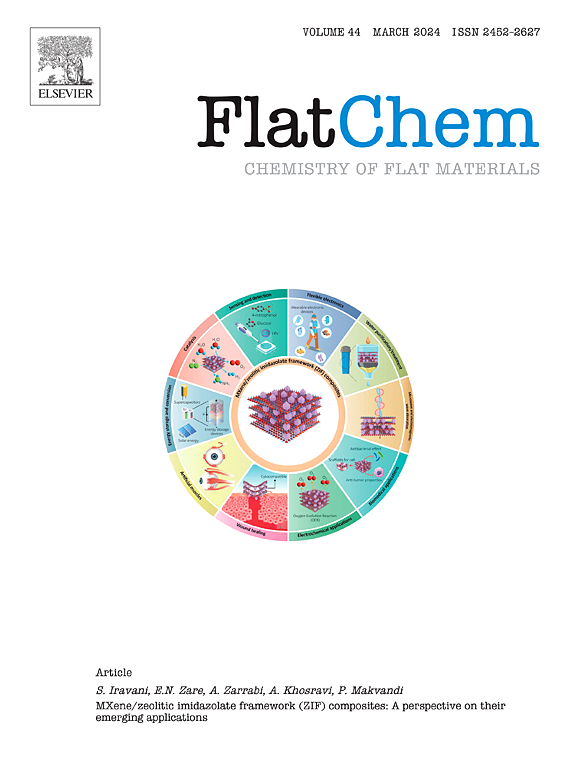The role of delaminating agents on the structure, morphology, bonding and electrical properties of HF etched MXenes
IF 6.2
3区 材料科学
Q2 CHEMISTRY, PHYSICAL
引用次数: 0
Abstract
MXenes (2-dimensional metal carbides and carbonitrides) have gained significant attention as layered materials due to their unique combination of high electrical conductivity and hydrophilic nature. In this study, titanium carbide MXene (Ti3C2Tx) nanosheets have been synthesized by etching the MAX phase (Ti3AlC2) using hydrofluoric acid (HF) and subsequently delaminated using three different reagents: Tetramethylammonium hydroxide (TMAOH), Dimethyl sulfoxide (DMSO) and Aqueous ammonia (aq. NH3). The impact of these delaminating agents on the structure, morphology and electrical properties of the resulting MXenes was thoroughly investigated to elucidate the underlying mechanisms. Experimental results reveal that TMAOH is more effective in achieving layer separation than DMSO and aqueous NH3. Field emission scanning electron microscopy (FESEM) images confirm superior delamination with TMAOH, resulting in thinner, more transparent sheets than those obtained with the other agents. Raman spectroscopy further confirms successful layer separation in samples delaminated with TMAOH and DMSO with various surface functional groups including –OH, –F, and =O present on all delaminated sheets indicating that functionalization occurs during delamination. The electrical conductivity measurements results reveal that the etched MAX phase (MX3) exhibits higher electrical conductivity than the delaminated samples of identical thickness, likely due to the Grotthuss mechanism of proton conductivity playing a dominant role.

脱层剂对HF蚀刻MXenes结构、形貌、键合及电性能的影响
MXenes(二维金属碳化物和碳氮化物)由于其高导电性和亲水性的独特组合而作为层状材料受到了极大的关注。在这项研究中,碳化钛MXene (Ti3C2Tx)纳米片是通过氢氟酸(HF)蚀刻MAX相(Ti3AlC2)合成的,然后用三种不同的试剂:四甲基氢氧化铵(TMAOH),二甲基亚砜(DMSO)和水氨(aq. NH3)进行分层。深入研究了这些脱层剂对所得MXenes结构、形貌和电性能的影响,以阐明其潜在的机制。实验结果表明,TMAOH比DMSO和水溶液NH3更有效地实现层分离。场发射扫描电子显微镜(FESEM)图像证实了TMAOH具有较好的分层效果,导致比使用其他试剂获得的薄片更薄,更透明。拉曼光谱进一步证实了用TMAOH和DMSO分层的样品的成功层分离,所有分层片上都存在各种表面官能团,包括-OH, -F和=O,这表明在分层过程中发生了功能化。电导率测量结果表明,蚀刻的MAX相(MX3)的电导率高于相同厚度的分层样品,这可能是由于质子电导率的Grotthuss机制起主导作用。
本文章由计算机程序翻译,如有差异,请以英文原文为准。
求助全文
约1分钟内获得全文
求助全文
来源期刊

FlatChem
Multiple-
CiteScore
8.40
自引率
6.50%
发文量
104
审稿时长
26 days
期刊介绍:
FlatChem - Chemistry of Flat Materials, a new voice in the community, publishes original and significant, cutting-edge research related to the chemistry of graphene and related 2D & layered materials. The overall aim of the journal is to combine the chemistry and applications of these materials, where the submission of communications, full papers, and concepts should contain chemistry in a materials context, which can be both experimental and/or theoretical. In addition to original research articles, FlatChem also offers reviews, minireviews, highlights and perspectives on the future of this research area with the scientific leaders in fields related to Flat Materials. Topics of interest include, but are not limited to, the following: -Design, synthesis, applications and investigation of graphene, graphene related materials and other 2D & layered materials (for example Silicene, Germanene, Phosphorene, MXenes, Boron nitride, Transition metal dichalcogenides) -Characterization of these materials using all forms of spectroscopy and microscopy techniques -Chemical modification or functionalization and dispersion of these materials, as well as interactions with other materials -Exploring the surface chemistry of these materials for applications in: Sensors or detectors in electrochemical/Lab on a Chip devices, Composite materials, Membranes, Environment technology, Catalysis for energy storage and conversion (for example fuel cells, supercapacitors, batteries, hydrogen storage), Biomedical technology (drug delivery, biosensing, bioimaging)
 求助内容:
求助内容: 应助结果提醒方式:
应助结果提醒方式:


